Dissertation: Implementation Factors of Flexible Work in Malaysia
VerifiedAdded on 2023/04/23
|102
|22375
|247
Dissertation
AI Summary
This dissertation provides a critical study of the factors influencing the implementation of flexible working arrangements (FWA) in the Malaysian service sector. It begins by establishing the background and research focus, highlighting the shift towards work-life balance and the increasing importance of non-monetary benefits in employee retention. The study investigates the social, economic, legal, and technological driving forces behind the need for FWA in Malaysia, particularly in the service sector. It also examines potential barriers and challenges from stakeholders' perspectives, drawing on literature from other countries and conducting a questionnaire survey and interviews within three Malaysian-based companies in aircraft maintenance, oil palm manufacturing equipment supply, and healthcare services. The research aims to understand the degree of acceptance of FWA in Malaysia as a developing country and explore the necessary prerequisites for successful adoption, ultimately contributing to a deeper understanding of FWA and its potential benefits for Malaysian organizations.
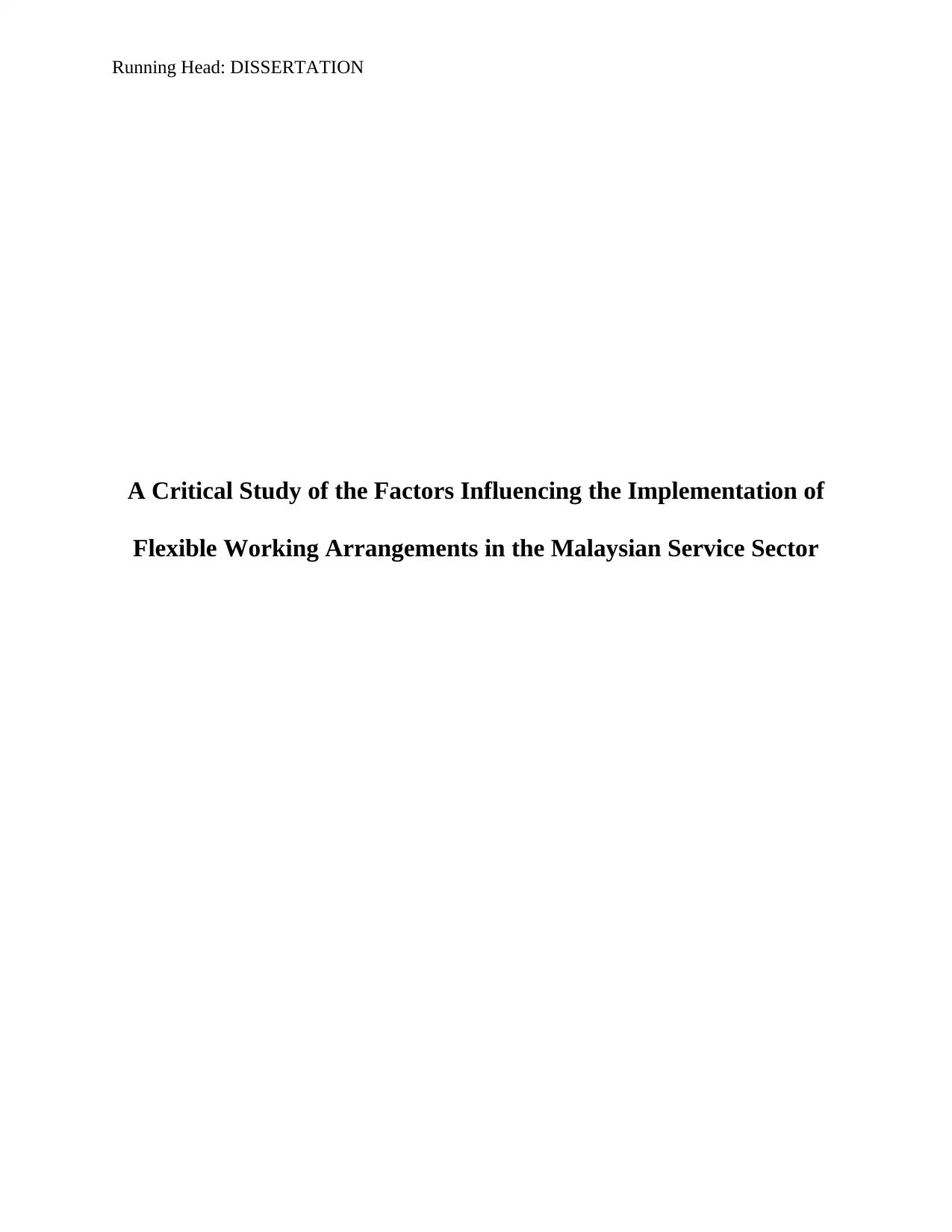
Running Head: DISSERTATION
A Critical Study of the Factors Influencing the Implementation of
Flexible Working Arrangements in the Malaysian Service Sector
A Critical Study of the Factors Influencing the Implementation of
Flexible Working Arrangements in the Malaysian Service Sector
Paraphrase This Document
Need a fresh take? Get an instant paraphrase of this document with our AI Paraphraser
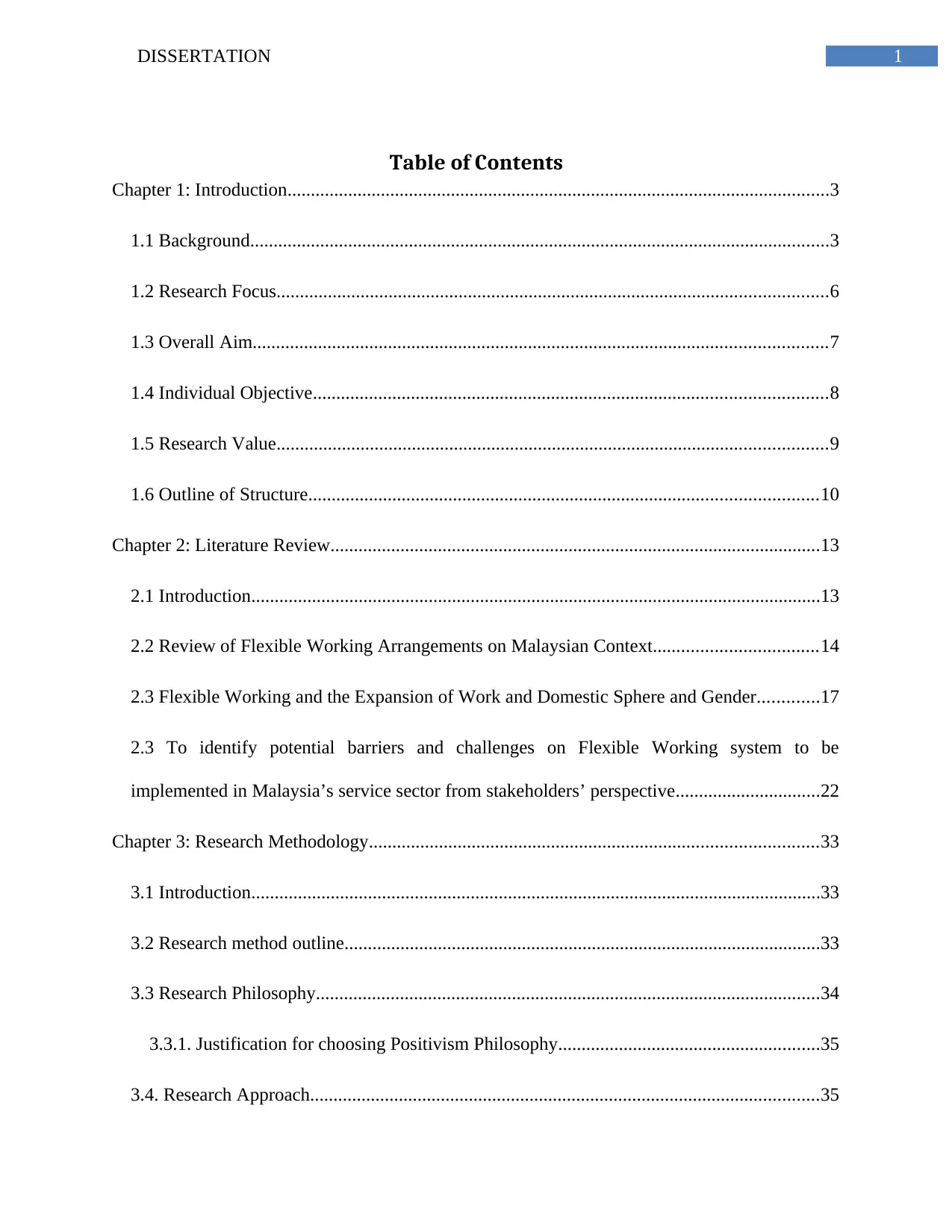
1DISSERTATION
Table of Contents
Chapter 1: Introduction....................................................................................................................3
1.1 Background............................................................................................................................3
1.2 Research Focus......................................................................................................................6
1.3 Overall Aim...........................................................................................................................7
1.4 Individual Objective..............................................................................................................8
1.5 Research Value......................................................................................................................9
1.6 Outline of Structure.............................................................................................................10
Chapter 2: Literature Review.........................................................................................................13
2.1 Introduction..........................................................................................................................13
2.2 Review of Flexible Working Arrangements on Malaysian Context...................................14
2.3 Flexible Working and the Expansion of Work and Domestic Sphere and Gender.............17
2.3 To identify potential barriers and challenges on Flexible Working system to be
implemented in Malaysia’s service sector from stakeholders’ perspective...............................22
Chapter 3: Research Methodology................................................................................................33
3.1 Introduction..........................................................................................................................33
3.2 Research method outline......................................................................................................33
3.3 Research Philosophy............................................................................................................34
3.3.1. Justification for choosing Positivism Philosophy........................................................35
3.4. Research Approach.............................................................................................................35
Table of Contents
Chapter 1: Introduction....................................................................................................................3
1.1 Background............................................................................................................................3
1.2 Research Focus......................................................................................................................6
1.3 Overall Aim...........................................................................................................................7
1.4 Individual Objective..............................................................................................................8
1.5 Research Value......................................................................................................................9
1.6 Outline of Structure.............................................................................................................10
Chapter 2: Literature Review.........................................................................................................13
2.1 Introduction..........................................................................................................................13
2.2 Review of Flexible Working Arrangements on Malaysian Context...................................14
2.3 Flexible Working and the Expansion of Work and Domestic Sphere and Gender.............17
2.3 To identify potential barriers and challenges on Flexible Working system to be
implemented in Malaysia’s service sector from stakeholders’ perspective...............................22
Chapter 3: Research Methodology................................................................................................33
3.1 Introduction..........................................................................................................................33
3.2 Research method outline......................................................................................................33
3.3 Research Philosophy............................................................................................................34
3.3.1. Justification for choosing Positivism Philosophy........................................................35
3.4. Research Approach.............................................................................................................35
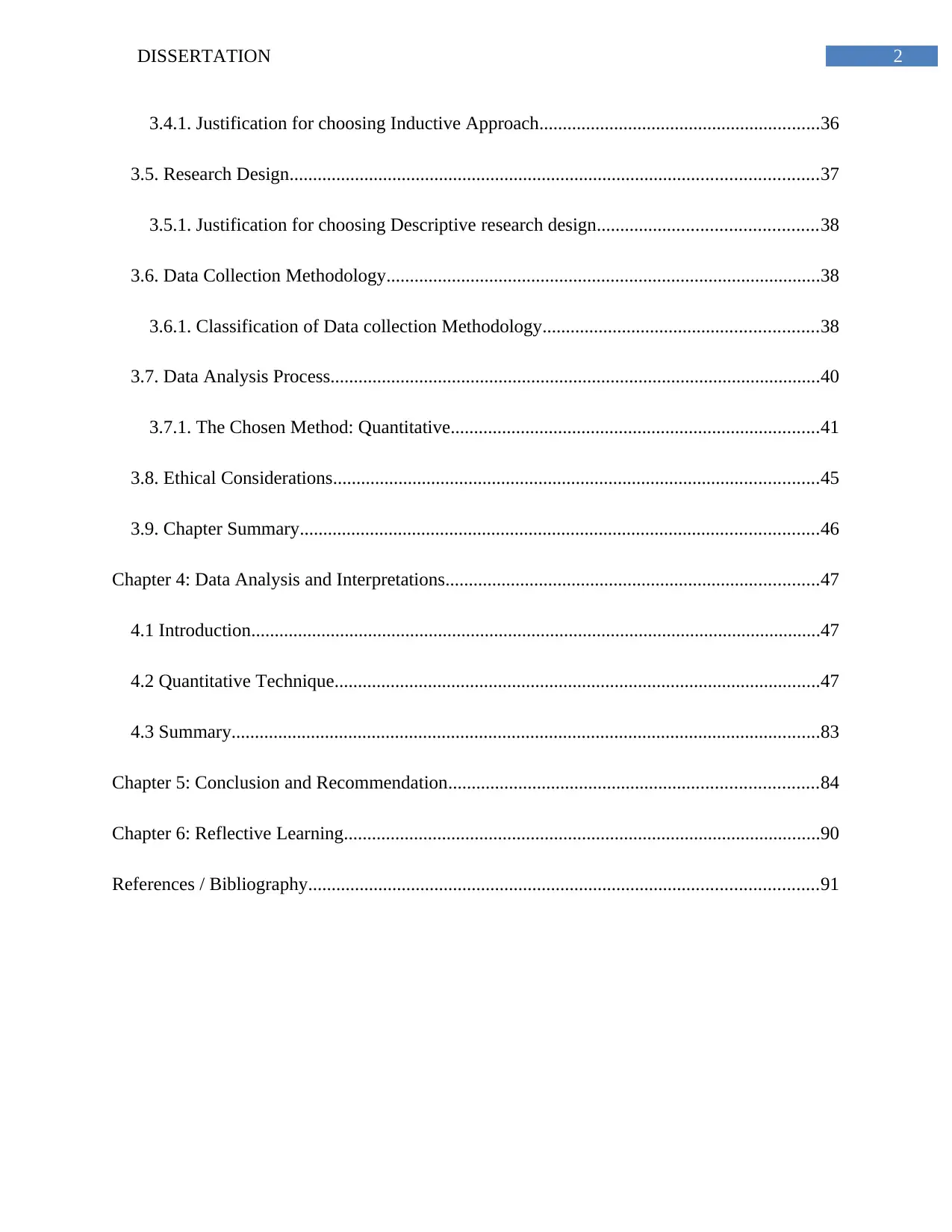
2DISSERTATION
3.4.1. Justification for choosing Inductive Approach............................................................36
3.5. Research Design.................................................................................................................37
3.5.1. Justification for choosing Descriptive research design...............................................38
3.6. Data Collection Methodology.............................................................................................38
3.6.1. Classification of Data collection Methodology...........................................................38
3.7. Data Analysis Process.........................................................................................................40
3.7.1. The Chosen Method: Quantitative...............................................................................41
3.8. Ethical Considerations........................................................................................................45
3.9. Chapter Summary...............................................................................................................46
Chapter 4: Data Analysis and Interpretations................................................................................47
4.1 Introduction..........................................................................................................................47
4.2 Quantitative Technique........................................................................................................47
4.3 Summary..............................................................................................................................83
Chapter 5: Conclusion and Recommendation...............................................................................84
Chapter 6: Reflective Learning......................................................................................................90
References / Bibliography.............................................................................................................91
3.4.1. Justification for choosing Inductive Approach............................................................36
3.5. Research Design.................................................................................................................37
3.5.1. Justification for choosing Descriptive research design...............................................38
3.6. Data Collection Methodology.............................................................................................38
3.6.1. Classification of Data collection Methodology...........................................................38
3.7. Data Analysis Process.........................................................................................................40
3.7.1. The Chosen Method: Quantitative...............................................................................41
3.8. Ethical Considerations........................................................................................................45
3.9. Chapter Summary...............................................................................................................46
Chapter 4: Data Analysis and Interpretations................................................................................47
4.1 Introduction..........................................................................................................................47
4.2 Quantitative Technique........................................................................................................47
4.3 Summary..............................................................................................................................83
Chapter 5: Conclusion and Recommendation...............................................................................84
Chapter 6: Reflective Learning......................................................................................................90
References / Bibliography.............................................................................................................91
⊘ This is a preview!⊘
Do you want full access?
Subscribe today to unlock all pages.

Trusted by 1+ million students worldwide

3DISSERTATION
Chapter 1: Introduction
1.1 Background
The working environment of the 21st century has evolved from one that is traditional
with rigid and fixed working hours, to one that addresses work-life balance. It is no secret, that
organizations today are increasingly facing severe skill shortages and challenges in employee
retention, which has necessitated the need to adopt a new approach that incorporates a culture of
trust in the form of offering flexibility to employees in the workplace (Office of the Focal Point
for Women, United Nations, 2010). Also, the evolution in demographics, cultural, economic and
legal environments have also brought about impacts on various human resource management
aspects, including employee recruitment and retention (Golden, 2008) (Vaiman, Scullion, &
Collings, 2012). The answer to this is the emergence of Flexible Working systems (FWS), or
known also as Flexible Working Arrangements (FWA) (Acas, 2015). Despite the fact that
monetary rewards such as salary, allowances and annual bonuses are still of paramount
importance to the employee, there has been a shift in emphasis towards non-monetary benefits,
where flexible working has been observed to be used as a tool to manage employee turnovers
(Smith, Oczkowski, & Smith, 2011) (Yamamoto, 2011). Scholars have argued that monetary
rewards alone are not sustainable drivers for job commitment and motivations, due to the social
value shifts among the younger generation (Arvanitis, 2005) (Gholipour, Bod, Zebtabi,
Pirannejad, & Kozekanan, 2010). Due to this reason, leading conglomerates around the world
such as Nestle and Vodafone (Bruhn, 2010) have implemented flexible working extensively
within their organisations in order to compete for the best talent.
As Malaysia strives hard to become a developed nation, it had slowly embraced
industrialization in the decades since gaining independence in 1957, when agriculture was still
Chapter 1: Introduction
1.1 Background
The working environment of the 21st century has evolved from one that is traditional
with rigid and fixed working hours, to one that addresses work-life balance. It is no secret, that
organizations today are increasingly facing severe skill shortages and challenges in employee
retention, which has necessitated the need to adopt a new approach that incorporates a culture of
trust in the form of offering flexibility to employees in the workplace (Office of the Focal Point
for Women, United Nations, 2010). Also, the evolution in demographics, cultural, economic and
legal environments have also brought about impacts on various human resource management
aspects, including employee recruitment and retention (Golden, 2008) (Vaiman, Scullion, &
Collings, 2012). The answer to this is the emergence of Flexible Working systems (FWS), or
known also as Flexible Working Arrangements (FWA) (Acas, 2015). Despite the fact that
monetary rewards such as salary, allowances and annual bonuses are still of paramount
importance to the employee, there has been a shift in emphasis towards non-monetary benefits,
where flexible working has been observed to be used as a tool to manage employee turnovers
(Smith, Oczkowski, & Smith, 2011) (Yamamoto, 2011). Scholars have argued that monetary
rewards alone are not sustainable drivers for job commitment and motivations, due to the social
value shifts among the younger generation (Arvanitis, 2005) (Gholipour, Bod, Zebtabi,
Pirannejad, & Kozekanan, 2010). Due to this reason, leading conglomerates around the world
such as Nestle and Vodafone (Bruhn, 2010) have implemented flexible working extensively
within their organisations in order to compete for the best talent.
As Malaysia strives hard to become a developed nation, it had slowly embraced
industrialization in the decades since gaining independence in 1957, when agriculture was still
Paraphrase This Document
Need a fresh take? Get an instant paraphrase of this document with our AI Paraphraser

4DISSERTATION
the predominant economic driver, and subsequently the manufacturing sector becoming the
leading sector in terms of employment between 1970 and 1980, and in terms of job creation
between 1985 and 1995 (Subramaniam, 2011).
In recent decades, the services sector has played a more pivotal role in employment
within Malaysia, thanks in part to Malaysia’s shift in government policy from the post-
independence labour-intensive industrialisation strategy to a knowledge and service-based
economy beginning in the 1990s (Subramaniam, 2011). Coupled with the advancement in
communication technologies such as email, tablets, mobile phones and high-speed internet
access, many companies have also followed suit in adopting these technologies in their
businesses, completely transforming the way employees work. This transformation is commonly
known as digitalisation of work, and with it, the boundaries between an employee’s private and
working space have been increasingly blurred, primarily caused by an increase in contact
between the employer and employee (Harteis, 2017).
The significance and practicality of Flexible Working (FW) have been further amplified
by the increasing number of women in the labour force, particularly in a fast-developing country
such as Malaysia. The fact that inflexibility at work, inability to achieve work/life balance still
exist in Malaysia has led to many married women leaving the labour force (Kaur, 2004) (Ariffin,
2009). It is also important to note that according to the World Bank Malaysian Economic
Monitor 2012, Malaysian women are more likely to receive a post-secondary education or higher
compared to Malaysian men (Sander, Jalil, Carpio, & Patrick, 2012). Sadly, despite making up
more than 50% of the total graduates in Malaysia as of 2012, women workforce only constitute
54.1% of the total number of Malaysian women of working age as of 2015 (flexWorkLife.my,
2018), reflecting the low women labour force participation phenomenon currently experienced
the predominant economic driver, and subsequently the manufacturing sector becoming the
leading sector in terms of employment between 1970 and 1980, and in terms of job creation
between 1985 and 1995 (Subramaniam, 2011).
In recent decades, the services sector has played a more pivotal role in employment
within Malaysia, thanks in part to Malaysia’s shift in government policy from the post-
independence labour-intensive industrialisation strategy to a knowledge and service-based
economy beginning in the 1990s (Subramaniam, 2011). Coupled with the advancement in
communication technologies such as email, tablets, mobile phones and high-speed internet
access, many companies have also followed suit in adopting these technologies in their
businesses, completely transforming the way employees work. This transformation is commonly
known as digitalisation of work, and with it, the boundaries between an employee’s private and
working space have been increasingly blurred, primarily caused by an increase in contact
between the employer and employee (Harteis, 2017).
The significance and practicality of Flexible Working (FW) have been further amplified
by the increasing number of women in the labour force, particularly in a fast-developing country
such as Malaysia. The fact that inflexibility at work, inability to achieve work/life balance still
exist in Malaysia has led to many married women leaving the labour force (Kaur, 2004) (Ariffin,
2009). It is also important to note that according to the World Bank Malaysian Economic
Monitor 2012, Malaysian women are more likely to receive a post-secondary education or higher
compared to Malaysian men (Sander, Jalil, Carpio, & Patrick, 2012). Sadly, despite making up
more than 50% of the total graduates in Malaysia as of 2012, women workforce only constitute
54.1% of the total number of Malaysian women of working age as of 2015 (flexWorkLife.my,
2018), reflecting the low women labour force participation phenomenon currently experienced
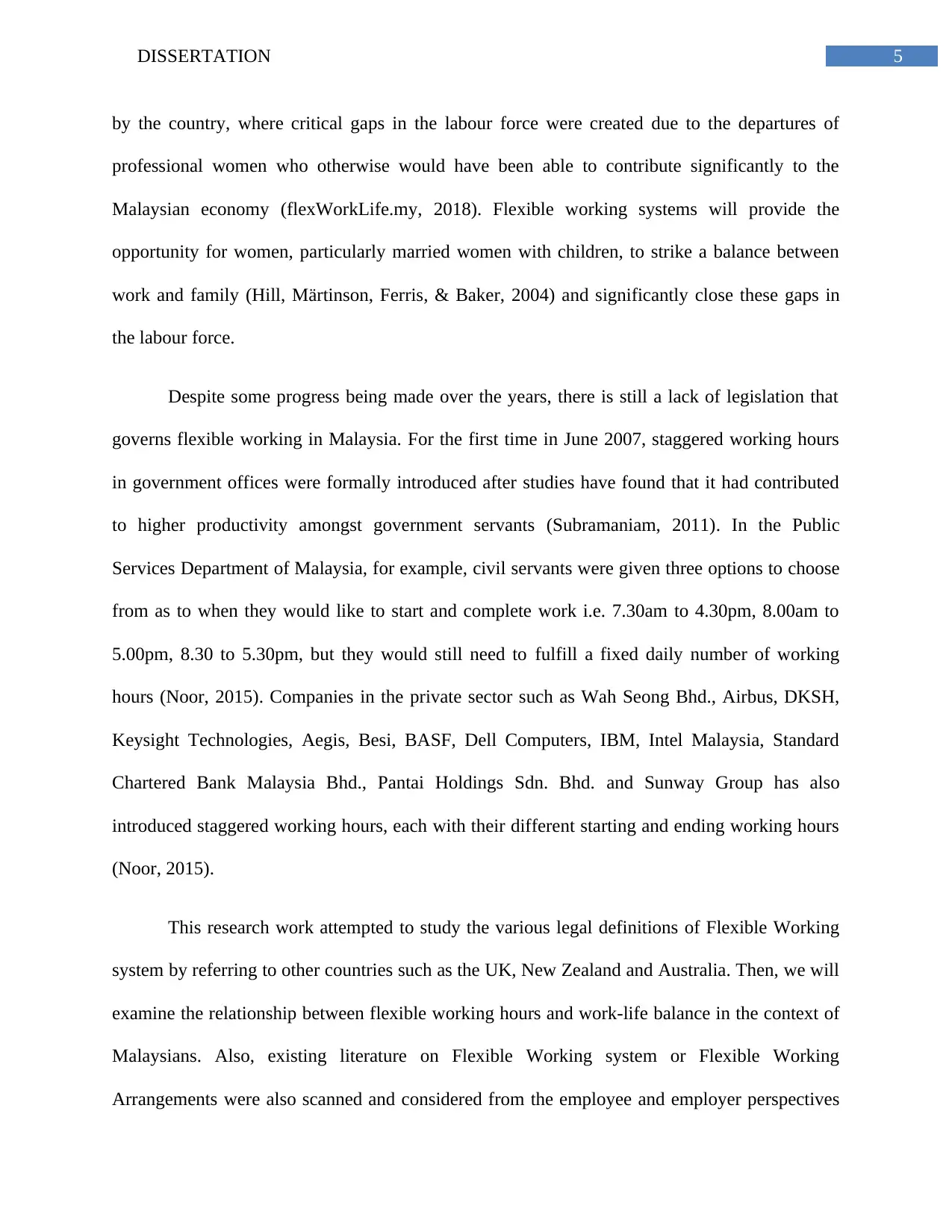
5DISSERTATION
by the country, where critical gaps in the labour force were created due to the departures of
professional women who otherwise would have been able to contribute significantly to the
Malaysian economy (flexWorkLife.my, 2018). Flexible working systems will provide the
opportunity for women, particularly married women with children, to strike a balance between
work and family (Hill, Märtinson, Ferris, & Baker, 2004) and significantly close these gaps in
the labour force.
Despite some progress being made over the years, there is still a lack of legislation that
governs flexible working in Malaysia. For the first time in June 2007, staggered working hours
in government offices were formally introduced after studies have found that it had contributed
to higher productivity amongst government servants (Subramaniam, 2011). In the Public
Services Department of Malaysia, for example, civil servants were given three options to choose
from as to when they would like to start and complete work i.e. 7.30am to 4.30pm, 8.00am to
5.00pm, 8.30 to 5.30pm, but they would still need to fulfill a fixed daily number of working
hours (Noor, 2015). Companies in the private sector such as Wah Seong Bhd., Airbus, DKSH,
Keysight Technologies, Aegis, Besi, BASF, Dell Computers, IBM, Intel Malaysia, Standard
Chartered Bank Malaysia Bhd., Pantai Holdings Sdn. Bhd. and Sunway Group has also
introduced staggered working hours, each with their different starting and ending working hours
(Noor, 2015).
This research work attempted to study the various legal definitions of Flexible Working
system by referring to other countries such as the UK, New Zealand and Australia. Then, we will
examine the relationship between flexible working hours and work-life balance in the context of
Malaysians. Also, existing literature on Flexible Working system or Flexible Working
Arrangements were also scanned and considered from the employee and employer perspectives
by the country, where critical gaps in the labour force were created due to the departures of
professional women who otherwise would have been able to contribute significantly to the
Malaysian economy (flexWorkLife.my, 2018). Flexible working systems will provide the
opportunity for women, particularly married women with children, to strike a balance between
work and family (Hill, Märtinson, Ferris, & Baker, 2004) and significantly close these gaps in
the labour force.
Despite some progress being made over the years, there is still a lack of legislation that
governs flexible working in Malaysia. For the first time in June 2007, staggered working hours
in government offices were formally introduced after studies have found that it had contributed
to higher productivity amongst government servants (Subramaniam, 2011). In the Public
Services Department of Malaysia, for example, civil servants were given three options to choose
from as to when they would like to start and complete work i.e. 7.30am to 4.30pm, 8.00am to
5.00pm, 8.30 to 5.30pm, but they would still need to fulfill a fixed daily number of working
hours (Noor, 2015). Companies in the private sector such as Wah Seong Bhd., Airbus, DKSH,
Keysight Technologies, Aegis, Besi, BASF, Dell Computers, IBM, Intel Malaysia, Standard
Chartered Bank Malaysia Bhd., Pantai Holdings Sdn. Bhd. and Sunway Group has also
introduced staggered working hours, each with their different starting and ending working hours
(Noor, 2015).
This research work attempted to study the various legal definitions of Flexible Working
system by referring to other countries such as the UK, New Zealand and Australia. Then, we will
examine the relationship between flexible working hours and work-life balance in the context of
Malaysians. Also, existing literature on Flexible Working system or Flexible Working
Arrangements were also scanned and considered from the employee and employer perspectives
⊘ This is a preview!⊘
Do you want full access?
Subscribe today to unlock all pages.

Trusted by 1+ million students worldwide

6DISSERTATION
to demonstrate that the system is beneficial for both parties in the context of the modern world.
Lastly, this research will investigate and clarify the contextual factors influencing the
implementation of Flexible Working system in Malaysia’s service sector which is available in
existing literature, drawing our conclusions by conducting a questionnaire survey in three
Malaysian-based companies involved in the service sector from a total of 150 respondents, as
well as from interviews with their senior management personnel.
1.2 Research Focus
Most of the existing studies on FWA are conducted in developed countries where salaries
are generally higher compared to that of developing countries (Idris, 2014). Unsurprisingly, the
basis for human resource management attitudes between developed and developing countries
have always been linked to the macro-environmental differences between them (Idris, 2014). For
example, it was discovered that 53% of Belgian managers believe that flexible working improves
employee productivity, while only 31% of managers in India share similar views (Regus Global
Report, 2011). These disparities in attitude between developed and developing nations will most
definitely influence the degree of acceptance and implementation of flexible working
arrangements in their respective countries. The same report also noted that the benefits that come
with flexible working are more appreciated by Western economies, the majority of which have
been “crisis-shaken” and have seen the need to scale down operations in order to make way for
recovery and achieve stability (Regus Global Report, 2011). Developed countries are more
technologically advanced at the edge of modernity and at the same time as a mature society
giving great importance to social benefits and work-life balance. However, in developing
countries, where industries are focusing on primary and secondary sectors, FW researches are
scarce. Fewer studies exist to help to answer questions such as ‘Could under development
to demonstrate that the system is beneficial for both parties in the context of the modern world.
Lastly, this research will investigate and clarify the contextual factors influencing the
implementation of Flexible Working system in Malaysia’s service sector which is available in
existing literature, drawing our conclusions by conducting a questionnaire survey in three
Malaysian-based companies involved in the service sector from a total of 150 respondents, as
well as from interviews with their senior management personnel.
1.2 Research Focus
Most of the existing studies on FWA are conducted in developed countries where salaries
are generally higher compared to that of developing countries (Idris, 2014). Unsurprisingly, the
basis for human resource management attitudes between developed and developing countries
have always been linked to the macro-environmental differences between them (Idris, 2014). For
example, it was discovered that 53% of Belgian managers believe that flexible working improves
employee productivity, while only 31% of managers in India share similar views (Regus Global
Report, 2011). These disparities in attitude between developed and developing nations will most
definitely influence the degree of acceptance and implementation of flexible working
arrangements in their respective countries. The same report also noted that the benefits that come
with flexible working are more appreciated by Western economies, the majority of which have
been “crisis-shaken” and have seen the need to scale down operations in order to make way for
recovery and achieve stability (Regus Global Report, 2011). Developed countries are more
technologically advanced at the edge of modernity and at the same time as a mature society
giving great importance to social benefits and work-life balance. However, in developing
countries, where industries are focusing on primary and secondary sectors, FW researches are
scarce. Fewer studies exist to help to answer questions such as ‘Could under development
Paraphrase This Document
Need a fresh take? Get an instant paraphrase of this document with our AI Paraphraser
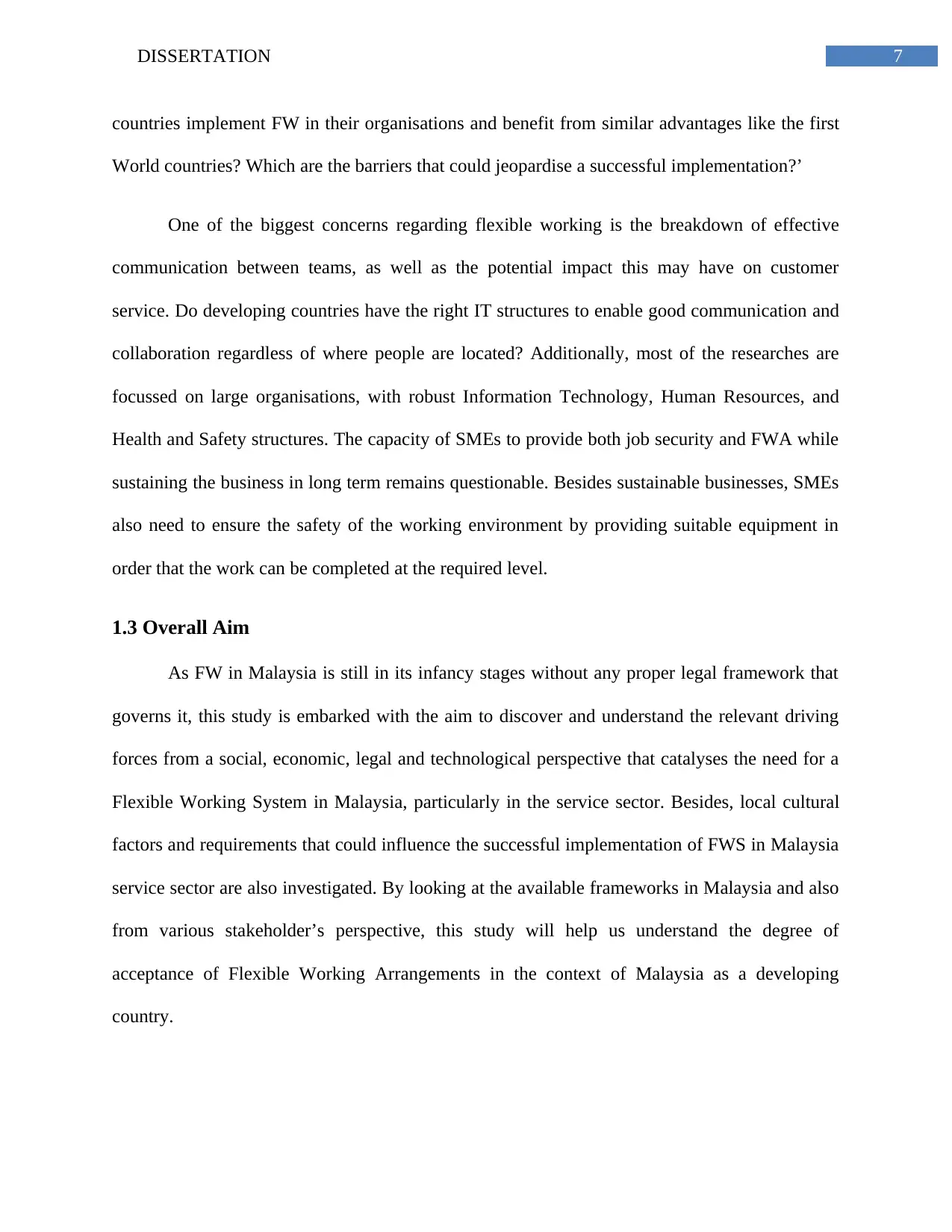
7DISSERTATION
countries implement FW in their organisations and benefit from similar advantages like the first
World countries? Which are the barriers that could jeopardise a successful implementation?’
One of the biggest concerns regarding flexible working is the breakdown of effective
communication between teams, as well as the potential impact this may have on customer
service. Do developing countries have the right IT structures to enable good communication and
collaboration regardless of where people are located? Additionally, most of the researches are
focussed on large organisations, with robust Information Technology, Human Resources, and
Health and Safety structures. The capacity of SMEs to provide both job security and FWA while
sustaining the business in long term remains questionable. Besides sustainable businesses, SMEs
also need to ensure the safety of the working environment by providing suitable equipment in
order that the work can be completed at the required level.
1.3 Overall Aim
As FW in Malaysia is still in its infancy stages without any proper legal framework that
governs it, this study is embarked with the aim to discover and understand the relevant driving
forces from a social, economic, legal and technological perspective that catalyses the need for a
Flexible Working System in Malaysia, particularly in the service sector. Besides, local cultural
factors and requirements that could influence the successful implementation of FWS in Malaysia
service sector are also investigated. By looking at the available frameworks in Malaysia and also
from various stakeholder’s perspective, this study will help us understand the degree of
acceptance of Flexible Working Arrangements in the context of Malaysia as a developing
country.
countries implement FW in their organisations and benefit from similar advantages like the first
World countries? Which are the barriers that could jeopardise a successful implementation?’
One of the biggest concerns regarding flexible working is the breakdown of effective
communication between teams, as well as the potential impact this may have on customer
service. Do developing countries have the right IT structures to enable good communication and
collaboration regardless of where people are located? Additionally, most of the researches are
focussed on large organisations, with robust Information Technology, Human Resources, and
Health and Safety structures. The capacity of SMEs to provide both job security and FWA while
sustaining the business in long term remains questionable. Besides sustainable businesses, SMEs
also need to ensure the safety of the working environment by providing suitable equipment in
order that the work can be completed at the required level.
1.3 Overall Aim
As FW in Malaysia is still in its infancy stages without any proper legal framework that
governs it, this study is embarked with the aim to discover and understand the relevant driving
forces from a social, economic, legal and technological perspective that catalyses the need for a
Flexible Working System in Malaysia, particularly in the service sector. Besides, local cultural
factors and requirements that could influence the successful implementation of FWS in Malaysia
service sector are also investigated. By looking at the available frameworks in Malaysia and also
from various stakeholder’s perspective, this study will help us understand the degree of
acceptance of Flexible Working Arrangements in the context of Malaysia as a developing
country.
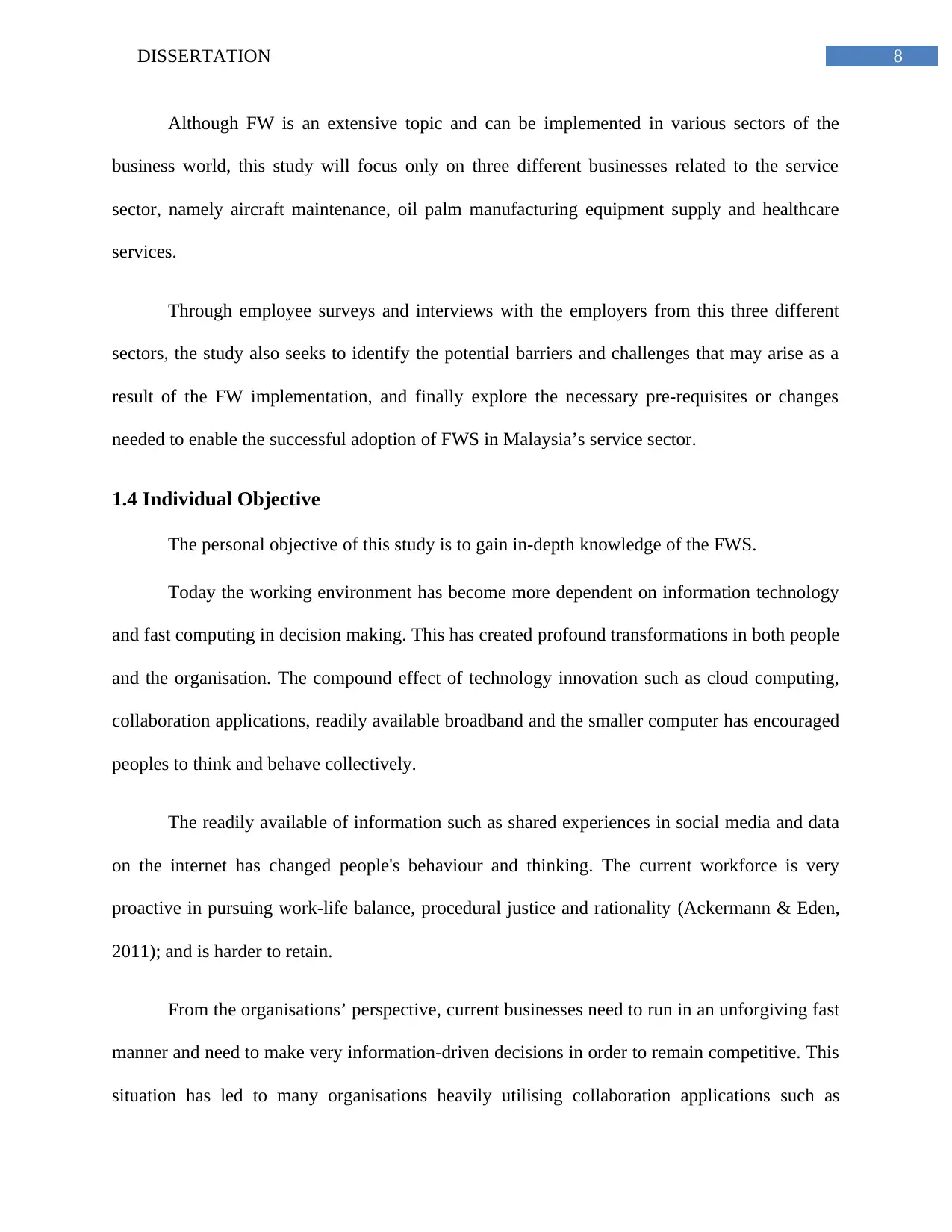
8DISSERTATION
Although FW is an extensive topic and can be implemented in various sectors of the
business world, this study will focus only on three different businesses related to the service
sector, namely aircraft maintenance, oil palm manufacturing equipment supply and healthcare
services.
Through employee surveys and interviews with the employers from this three different
sectors, the study also seeks to identify the potential barriers and challenges that may arise as a
result of the FW implementation, and finally explore the necessary pre-requisites or changes
needed to enable the successful adoption of FWS in Malaysia’s service sector.
1.4 Individual Objective
The personal objective of this study is to gain in-depth knowledge of the FWS.
Today the working environment has become more dependent on information technology
and fast computing in decision making. This has created profound transformations in both people
and the organisation. The compound effect of technology innovation such as cloud computing,
collaboration applications, readily available broadband and the smaller computer has encouraged
peoples to think and behave collectively.
The readily available of information such as shared experiences in social media and data
on the internet has changed people's behaviour and thinking. The current workforce is very
proactive in pursuing work-life balance, procedural justice and rationality (Ackermann & Eden,
2011); and is harder to retain.
From the organisations’ perspective, current businesses need to run in an unforgiving fast
manner and need to make very information-driven decisions in order to remain competitive. This
situation has led to many organisations heavily utilising collaboration applications such as
Although FW is an extensive topic and can be implemented in various sectors of the
business world, this study will focus only on three different businesses related to the service
sector, namely aircraft maintenance, oil palm manufacturing equipment supply and healthcare
services.
Through employee surveys and interviews with the employers from this three different
sectors, the study also seeks to identify the potential barriers and challenges that may arise as a
result of the FW implementation, and finally explore the necessary pre-requisites or changes
needed to enable the successful adoption of FWS in Malaysia’s service sector.
1.4 Individual Objective
The personal objective of this study is to gain in-depth knowledge of the FWS.
Today the working environment has become more dependent on information technology
and fast computing in decision making. This has created profound transformations in both people
and the organisation. The compound effect of technology innovation such as cloud computing,
collaboration applications, readily available broadband and the smaller computer has encouraged
peoples to think and behave collectively.
The readily available of information such as shared experiences in social media and data
on the internet has changed people's behaviour and thinking. The current workforce is very
proactive in pursuing work-life balance, procedural justice and rationality (Ackermann & Eden,
2011); and is harder to retain.
From the organisations’ perspective, current businesses need to run in an unforgiving fast
manner and need to make very information-driven decisions in order to remain competitive. This
situation has led to many organisations heavily utilising collaboration applications such as
⊘ This is a preview!⊘
Do you want full access?
Subscribe today to unlock all pages.

Trusted by 1+ million students worldwide

9DISSERTATION
enterprise resource planning (ERP), advanced telecommunication and shared documentation via
a fast network and with portable computers to work virtually.
It is thought the FW system is a suitable arrangement that addresses both current
workforce behaviour and business requirements (Kelliher & Anderson, 2009). This
understanding will enable critical evaluation of the need for FWS in the current working
organisation. The knowledge shall also strengthen enhance the FWA implementation in the
workplace in the foreseeable future.
1.5 Research Value
This study shall benefit Malaysian organisations that have the intention to introduce
Flexible Working system. A flexible work environment can bring benefits to both employers and
employees. Employees have the possibility to work in a favourable ecosystem that increases
freedom, while employers can benefit from a happier and more motivated working workforce.
This conducive environment can contribute to a positive impact on productivity, engagement and
motivation, translating into improved performance and staff retention. Malaysian organisations
adopting FW could reduce the level of absenteeism, sickness and stress and adapt the working
hours to the way best suit the organisation, its employees and its customers.
Employees who benefit from flexible working arrangements shall eventually be
empowered to have control over their working day and adapt their time in the most productive
manner based on their routines. Flexible working can contribute to reducing stress and fatigue;
factors which may lead to employees losing focus and motivation and as a result,
underperforming at their job function. Also allows employers to better balance work demands
with personal demands ensuring improved concentration on work tasks during work hours. A
enterprise resource planning (ERP), advanced telecommunication and shared documentation via
a fast network and with portable computers to work virtually.
It is thought the FW system is a suitable arrangement that addresses both current
workforce behaviour and business requirements (Kelliher & Anderson, 2009). This
understanding will enable critical evaluation of the need for FWS in the current working
organisation. The knowledge shall also strengthen enhance the FWA implementation in the
workplace in the foreseeable future.
1.5 Research Value
This study shall benefit Malaysian organisations that have the intention to introduce
Flexible Working system. A flexible work environment can bring benefits to both employers and
employees. Employees have the possibility to work in a favourable ecosystem that increases
freedom, while employers can benefit from a happier and more motivated working workforce.
This conducive environment can contribute to a positive impact on productivity, engagement and
motivation, translating into improved performance and staff retention. Malaysian organisations
adopting FW could reduce the level of absenteeism, sickness and stress and adapt the working
hours to the way best suit the organisation, its employees and its customers.
Employees who benefit from flexible working arrangements shall eventually be
empowered to have control over their working day and adapt their time in the most productive
manner based on their routines. Flexible working can contribute to reducing stress and fatigue;
factors which may lead to employees losing focus and motivation and as a result,
underperforming at their job function. Also allows employers to better balance work demands
with personal demands ensuring improved concentration on work tasks during work hours. A
Paraphrase This Document
Need a fresh take? Get an instant paraphrase of this document with our AI Paraphraser
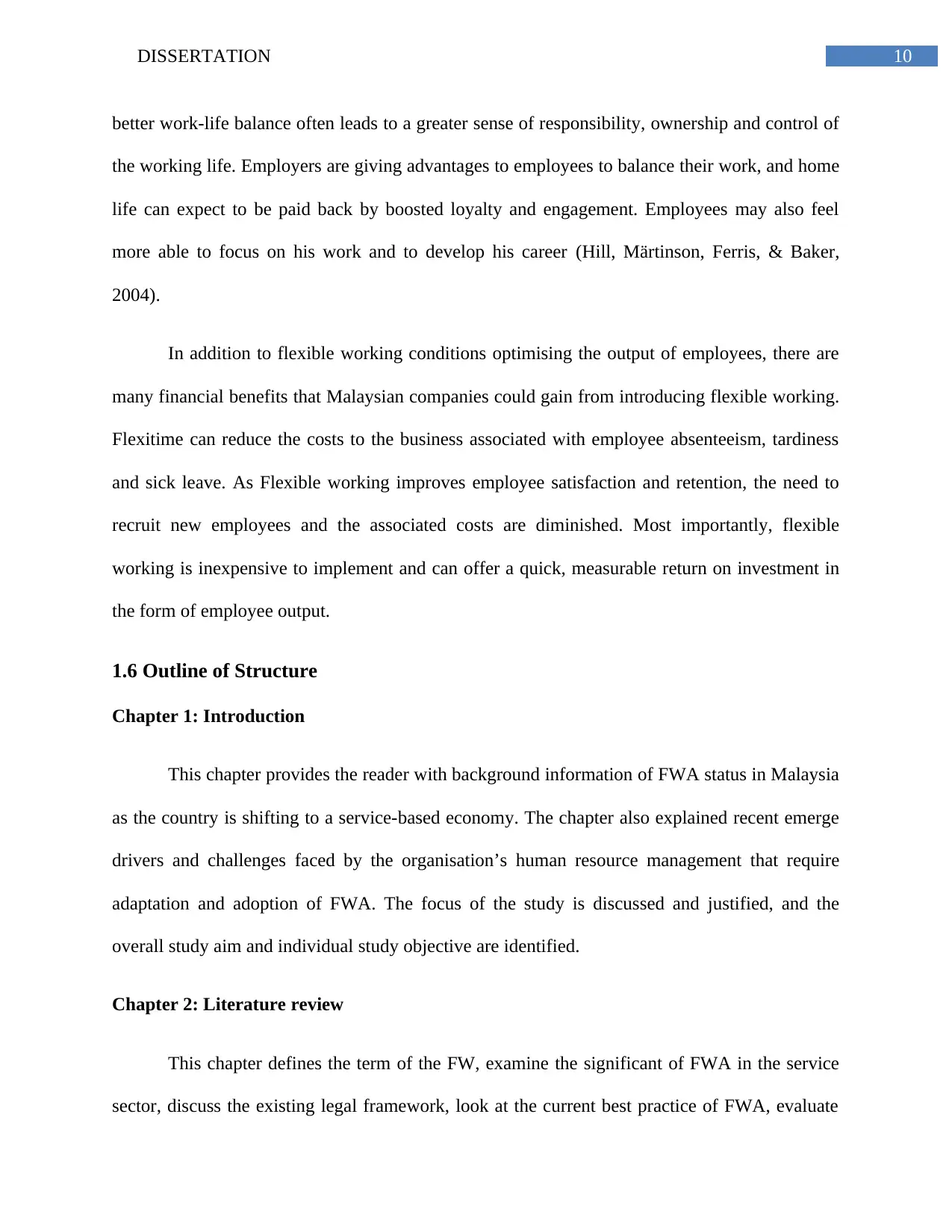
10DISSERTATION
better work-life balance often leads to a greater sense of responsibility, ownership and control of
the working life. Employers are giving advantages to employees to balance their work, and home
life can expect to be paid back by boosted loyalty and engagement. Employees may also feel
more able to focus on his work and to develop his career (Hill, Märtinson, Ferris, & Baker,
2004).
In addition to flexible working conditions optimising the output of employees, there are
many financial benefits that Malaysian companies could gain from introducing flexible working.
Flexitime can reduce the costs to the business associated with employee absenteeism, tardiness
and sick leave. As Flexible working improves employee satisfaction and retention, the need to
recruit new employees and the associated costs are diminished. Most importantly, flexible
working is inexpensive to implement and can offer a quick, measurable return on investment in
the form of employee output.
1.6 Outline of Structure
Chapter 1: Introduction
This chapter provides the reader with background information of FWA status in Malaysia
as the country is shifting to a service-based economy. The chapter also explained recent emerge
drivers and challenges faced by the organisation’s human resource management that require
adaptation and adoption of FWA. The focus of the study is discussed and justified, and the
overall study aim and individual study objective are identified.
Chapter 2: Literature review
This chapter defines the term of the FW, examine the significant of FWA in the service
sector, discuss the existing legal framework, look at the current best practice of FWA, evaluate
better work-life balance often leads to a greater sense of responsibility, ownership and control of
the working life. Employers are giving advantages to employees to balance their work, and home
life can expect to be paid back by boosted loyalty and engagement. Employees may also feel
more able to focus on his work and to develop his career (Hill, Märtinson, Ferris, & Baker,
2004).
In addition to flexible working conditions optimising the output of employees, there are
many financial benefits that Malaysian companies could gain from introducing flexible working.
Flexitime can reduce the costs to the business associated with employee absenteeism, tardiness
and sick leave. As Flexible working improves employee satisfaction and retention, the need to
recruit new employees and the associated costs are diminished. Most importantly, flexible
working is inexpensive to implement and can offer a quick, measurable return on investment in
the form of employee output.
1.6 Outline of Structure
Chapter 1: Introduction
This chapter provides the reader with background information of FWA status in Malaysia
as the country is shifting to a service-based economy. The chapter also explained recent emerge
drivers and challenges faced by the organisation’s human resource management that require
adaptation and adoption of FWA. The focus of the study is discussed and justified, and the
overall study aim and individual study objective are identified.
Chapter 2: Literature review
This chapter defines the term of the FW, examine the significant of FWA in the service
sector, discuss the existing legal framework, look at the current best practice of FWA, evaluate
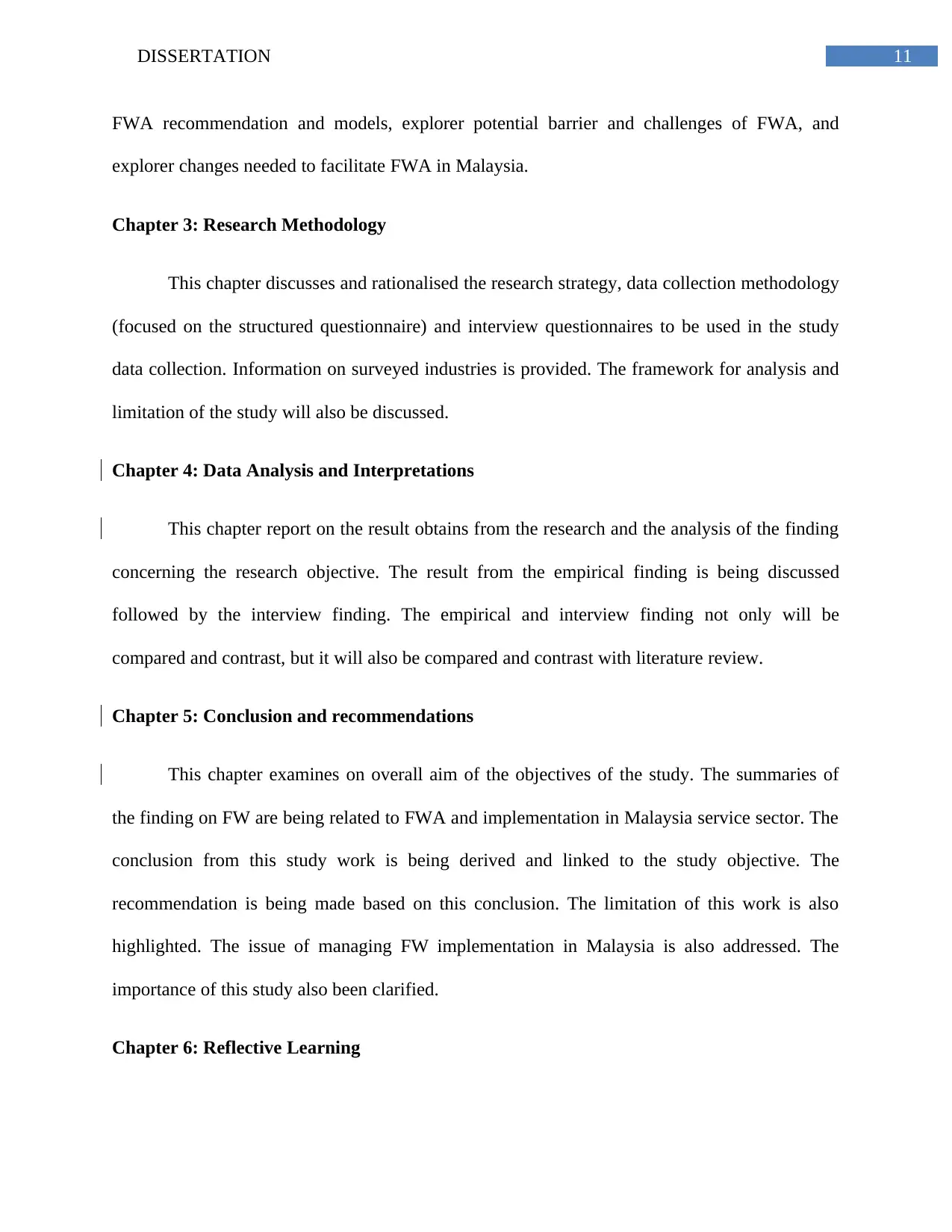
11DISSERTATION
FWA recommendation and models, explorer potential barrier and challenges of FWA, and
explorer changes needed to facilitate FWA in Malaysia.
Chapter 3: Research Methodology
This chapter discusses and rationalised the research strategy, data collection methodology
(focused on the structured questionnaire) and interview questionnaires to be used in the study
data collection. Information on surveyed industries is provided. The framework for analysis and
limitation of the study will also be discussed.
Chapter 4: Data Analysis and Interpretations
This chapter report on the result obtains from the research and the analysis of the finding
concerning the research objective. The result from the empirical finding is being discussed
followed by the interview finding. The empirical and interview finding not only will be
compared and contrast, but it will also be compared and contrast with literature review.
Chapter 5: Conclusion and recommendations
This chapter examines on overall aim of the objectives of the study. The summaries of
the finding on FW are being related to FWA and implementation in Malaysia service sector. The
conclusion from this study work is being derived and linked to the study objective. The
recommendation is being made based on this conclusion. The limitation of this work is also
highlighted. The issue of managing FW implementation in Malaysia is also addressed. The
importance of this study also been clarified.
Chapter 6: Reflective Learning
FWA recommendation and models, explorer potential barrier and challenges of FWA, and
explorer changes needed to facilitate FWA in Malaysia.
Chapter 3: Research Methodology
This chapter discusses and rationalised the research strategy, data collection methodology
(focused on the structured questionnaire) and interview questionnaires to be used in the study
data collection. Information on surveyed industries is provided. The framework for analysis and
limitation of the study will also be discussed.
Chapter 4: Data Analysis and Interpretations
This chapter report on the result obtains from the research and the analysis of the finding
concerning the research objective. The result from the empirical finding is being discussed
followed by the interview finding. The empirical and interview finding not only will be
compared and contrast, but it will also be compared and contrast with literature review.
Chapter 5: Conclusion and recommendations
This chapter examines on overall aim of the objectives of the study. The summaries of
the finding on FW are being related to FWA and implementation in Malaysia service sector. The
conclusion from this study work is being derived and linked to the study objective. The
recommendation is being made based on this conclusion. The limitation of this work is also
highlighted. The issue of managing FW implementation in Malaysia is also addressed. The
importance of this study also been clarified.
Chapter 6: Reflective Learning
⊘ This is a preview!⊘
Do you want full access?
Subscribe today to unlock all pages.

Trusted by 1+ million students worldwide
1 out of 102
Related Documents
Your All-in-One AI-Powered Toolkit for Academic Success.
+13062052269
info@desklib.com
Available 24*7 on WhatsApp / Email
![[object Object]](/_next/static/media/star-bottom.7253800d.svg)
Unlock your academic potential
Copyright © 2020–2025 A2Z Services. All Rights Reserved. Developed and managed by ZUCOL.





